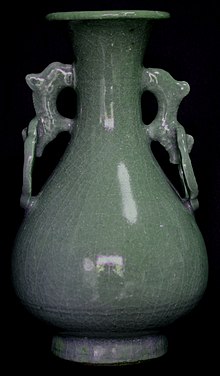| Celadon | |||||||||||||||||
|---|---|---|---|---|---|---|---|---|---|---|---|---|---|---|---|---|---|
 | |||||||||||||||||
| Traditional Chinese | 青瓷 | ||||||||||||||||
| Simplified Chinese | 青瓷 | ||||||||||||||||
| Literal meaning | "blue-green porcelain" | ||||||||||||||||
| |||||||||||||||||
Celadon (/ˈsɛlədɒn/) is a term for pottery denoting both wares glazed in the jade green celadon color, also known as greenware or "green ware" (the term specialists now tend to use),[1] and a type of transparent glaze, often with small cracks, that was first used on greenware, but later used on other porcelains. Celadon originated in China, though the term is purely European, and notable kilns such as the Longquan kiln in Zhejiang province are renowned for their celadon glazes.[2] Celadon production later spread to other parts of East Asia, such as Japan and Korea,[3] as well as Southeast Asian countries, such as Thailand. Eventually, European potteries produced some pieces, but it was never a major element there. Finer pieces are in porcelain, but both the color and the glaze can be produced in stoneware and earthenware. Most of the earlier Longquan celadon is on the border of stoneware and porcelain, meeting the Chinese but not the European definitions of porcelain.
For many centuries, celadon wares were highly regarded by the Chinese imperial court, before being replaced in fashion by painted wares, especially the new blue and white porcelain under the Yuan dynasty. The similarity of the color to jade, traditionally the most highly valued material in China, was a large part of its attraction. Celadon continued to be produced in China at a lower level, often with a conscious sense of reviving older styles. In Korea the celadons produced under the Goryeo dynasty (918–1392) are regarded as the classic wares of Korean porcelain.
The celadon color is classically produced by firing a glaze containing a little iron oxide at a high temperature in a reducing kiln. The materials must be refined, as other chemicals can alter the color completely. Too little iron oxide causes a blue color (sometimes a desired effect), and too much gives olive and finally black; the right amount is between 0.75% and 2.5%. The presence of other chemicals may have effects; titanium dioxide gives a yellowish tinge.[4]
- ^ British Museum glossary; Christie's Collector's Guide; this is not to be confused with "greenware", meaning unfired clay pottery, as a stage of production.
- ^ "Chinese Porcelain Glossary: Celadon". Gotheborg.com. Retrieved 2017-03-17.
- ^ "Goryeo Celadon | Essay | Heilbrunn Timeline of Art History". The Metropolitan Museum of Art. Retrieved 2017-03-17.
- ^ Vainker, S. J., Chinese Pottery and Porcelain, 1991, British Museum Press, pp. 53–55, ISBN 9780714114705.